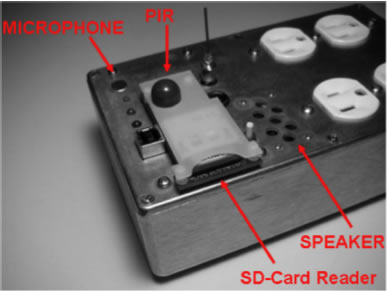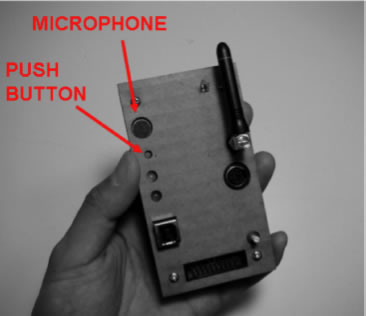Science Fiction
Dictionary
A B C D E F G H I J K L M N O P Q R S T U V W X Y Z
MIT Conversation Shielding Like Cone Of Silence

Distributed acoustic conversation shielding is the subject of a new patent by MIT Media Lab researchers. The device is designed to protect the privacy of spontaneous workplace conversations with sound from distributed loudspeakers. The units could be disguised as power strips.

(Conversation shielding 'power strip' [pdf])
This usage scenario is taken from the earlier paper Distributed Acoustic Conversation Shielding: An Application of a Smart Transducer Network by Yasuhiro Ono*, Joshua Lifton, Mark Feldmeier, Joseph A. Paradiso.
An office worker happened to meet one of his colleagues, a team member of a project, in the open space of their office area, and they started to chat about their project. He noticed that the content of the conversation was getting rather confidential to people outside their team. He pushes a button on his mobile device to trigger the acoustic conversation shielding application, at which point, various speakers surrounding them start to emit a masking sound to prevent others from overhearing the conversation. When the conversation is over, he pushes the button again to stop the masking.
Here's a prototype version of a conversation shielding wearable controller.

(Conversation shielding wearable controller [pdf])
They actually tested this idea with a network of 12 units, about two meters apart, with some success. The masking sounds decreased the signal-to-noise ratio by 5-10 dB at each location.
Science fiction readers (and television watchers) find this idea familiar. Most of us recall the cone of silence made famous in the Sixties television show Get Smart. Take a look at this commercial which shows the cone of silence in use.
(Cone of silence in Get Smart)
Perhaps more specifically, Frank Herbert used the term and the basic idea and the term cone of silence in his 1958 short story Cease Fire.
SF readers also recall the Fenton silencer from Arthur C. Clarke's 1957 story Silence Please.
It consisted of a microphone, a special amplifier and a pair of loud speakers. Any sound that happened to be about was picked up by the mike, amplified and inverted so it was exactly out of phase with the original noise. Then it was pumped out of the speakers, the original wave and the new one cancelled out, and the net result was silence.
(Read more about Clarke's Fenton silencer)
A year earlier, Robert Heinlein wrote about a hush corner in his 1956 novel Double Star.
Sometimes such facilities in public places like hotels are not all that they might be; the sound waves fail to cancel out completely. But the Eisenhower is a luxury house and in this case, at least, the equipment worked perfectly; I could see their lips move but I could hear no sound.
As far as I know, the earliest use of the cone of silence term and idea occurred in a 1955 episode of Science Fiction Theatre entitled "Barrier of Silence."
From Distributed Acoustic Conversation Shielding: An Application of a Smart Transducer Network [pdf] and Distributed Acoustic Conversation Shielding System [patent application]; via New Scientist.
Scroll down for more stories in the same category. (Story submitted 5/10/2009)
Follow this kind of news @Technovelgy.| Email | RSS | Blog It | Stumble | del.icio.us | Digg | Reddit |
Would
you like to contribute a story tip?
It's easy:
Get the URL of the story, and the related sf author, and add
it here.
Comment/Join discussion ( 1 )
Related News Stories - (" Engineering ")
The Zapata Air Scooter Would Be Great In A Science Fiction Story
'Betty's slapdash style.'
Could Crystal Batteries Generate Power For Centuries?
'Power could be compressed thus into an inch-square cube of what looked like blue-white ice' - Edmond Hamilton, 1940.
Replace The Smartphone With A Connected Edge Node For AI Inference
'Buy a Little Dingbat... electropen, wrist watch, pocketphone, pocket radio, billfold ... all in one.' - Raymond F. Jones, 1945.
Sunday Robotics 'Memo' Bot Has Unique Training Glove
'He then started hand movements of definite pattern...' - Robert Heinlein, 1942
Technovelgy (that's tech-novel-gee!) is devoted to the creative science inventions and ideas of sf authors. Look for the Invention Category that interests you, the Glossary, the Invention Timeline, or see what's New.
Science Fiction
Timeline
1600-1899
1900-1939
1940's 1950's
1960's 1970's
1980's 1990's
2000's 2010's
Current News
The Zapata Air Scooter Would Be Great In A Science Fiction Story
'Betty's slapdash style.'
Thermostabilized Wet Meat Product (NASA Prototype)
There are no orbiting Michelin stars. Yet.
Could Crystal Batteries Generate Power For Centuries?
'Power could be compressed thus into an inch-square cube of what looked like blue-white ice'
India Ponders Always-On Smartphone Location Tracking
'It is necessary... for your own protection.'
Amazon Will Send You Heinlein's Knockdown Cabin
'It's so light that you can set it up in five minutes by yourself...'
Is It Time To Forbid Human Driving?
'Heavy penalties... were to be applied to any one found driving manually-controlled machines.'
Replace The Smartphone With A Connected Edge Node For AI Inference
'Buy a Little Dingbat... electropen, wrist watch, pocketphone, pocket radio, billfold ... all in one.'
Artificial Skin For Robots Is Coming Right Along
'... an elastic, tinted material that had all the feel and appearance of human flesh and epidermis.'
Robot Guard Dog On Duty
I might also be thinking of K-9 from Doctor Who.
Wearable Artificial Fabric Muscles
'It is remarkable that the long leverages of their machines are in most cases actuated by a sort of sham musculature...'
BrainBridge Concept Transplant Of Human Head Proposed
'Briquet’s head seemed to think that to find and attach a new body to her head was as easy as to fit and sew a new dress.'
Google's Nano Banana Pro Presents Handwritten Math Solutions
'...copy was turned out in a charming and entirely feminine handwriting.'
Edible Meat-Like Fungus Like Barbara Hambly's Slunch?
'It was almost unheard of for slunch to spread that fast...'
Sunday Robotics 'Memo' Bot Has Unique Training Glove
'He then started hand movements of definite pattern...'
Woman Marries Computer, Vonnegut's Dream Comes True
'Men are made of protoplasm... Lasts forever.'
Natural Gait With Prosthetic Connected To Nervous System
'The leg was to function, in a way, as a servo-mechanism operated by Larry’s brain...'
